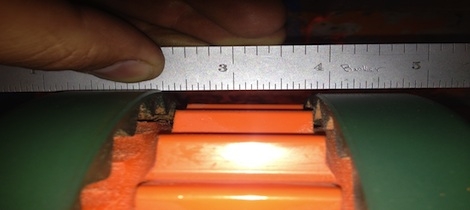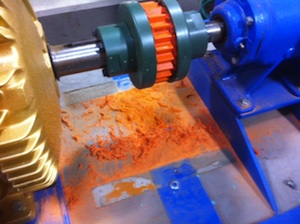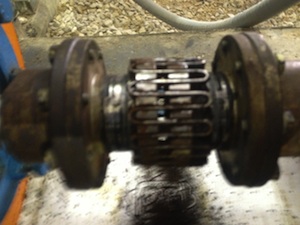One thing that should never be left out of the shaft alignment process is a good coupling inspection. Because if a coupling or coupling insert is excessively worn or damaged, it should not be aligned until the coupling is repaired or replaced.
If it looks misaligned by performing a coupling inspection with a good old-fashioned straightedge, it probably is. But there is more to performing a coupling inspection than just seeing if the coupling is aligned.
General
• Check for proper torque on the set screws.
• Check for wear or looseness in the keys.
• Check for cracks and shaft wear, which could indicate a loose hub.
• Confirm proper bolting of any coupling components.
• Check to see if the guard has been rubbing against the coupling. If so, the guard may need repair or adjustment. If the guard has rubbed against the coupling insert, it may need replacing.
• If the coupling is lubricated, check to confirm that lubricant is not leaking out being slung out of the coupling. If it is, the gaskets or sealing rings may need replacing, and more lubricant may need to be added.
Elastomeric Couplings
• Gear-type (Sureflex) – Look for excessive wear of the teeth on the insert. If coupling material is built up within the mating teeth of the hubs, it should be scraped out and removed. If the insert has cracks from dry rot, replace it. If the insert has been twisted by more than 1 tooth from start-up torque, replace it. And if there is a big pile of orange or black dust under and orange or black insert, rest assured it needs both replacing, and aligning.
• “Tire” (Omega) – Check for cracking in the “tire”. If excessive cracking is noted, replace it. Check for proper bolting tension on the hubs.
• Spider – Look for excessive backlash, which is indicative of looseness and elastic failure of the insert. Replace as needed.
Disc-Pack Couplings
• Inspect the disc packs (shims) for cracks and waves.
• If the “shims” are cracked or deformed, replace them.
• Check the hub bushings. If they are worn, they can often be replaced without replacing the entire coupling.
Grid-type Couplings
• Inspect the grid (spring) for wear, especially across the flat faces, and in the turns. Look for wear on the hub teeth as well.
• Ensure proper lubrication. And if a huge pile of dust falls out when you remove the “shell”, replace the entire coupling, hubs and all. Any coupling that requires lubrication should be checked on a regular basis as part of good maintenance practices.
Gear Couplings
• Ensure proper lubrication. Check for tooth wear, and proper bolting torque.
Flexible couplings are meant to transfer power from the driving machine to the driven
machine, but they also meant to be a weak link between machines. But if properly
sized, aligned, and lubricated, flexible couplings should provide many years of troublefree service.
For more information, please contact Chris at cogentcompanies.com or Stan at VibrAlign.com.








Comments